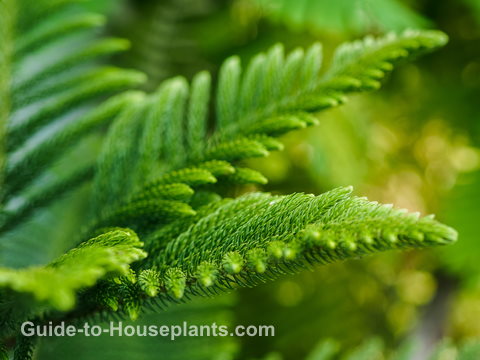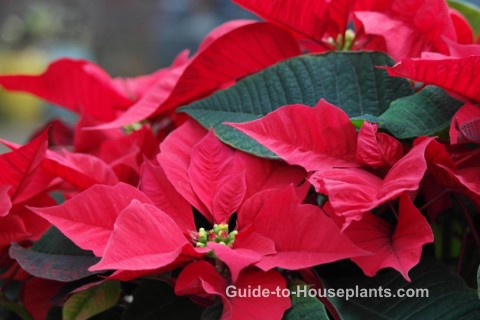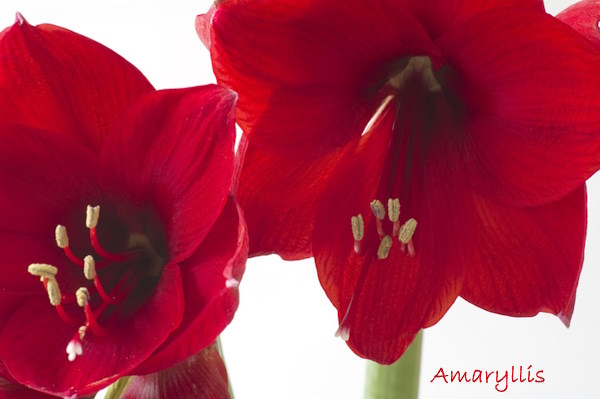Oncidium Orchid Care
Most Oncidium orchid species produce dozens of small flowers at the same time, giving a spectacular show that lasts for several weeks. The large-lipped flowers may be yellow, white, red, pink, green or brown.
Oncidium goes by the common name Dancing Lady Orchid. In this guide, you'll discover indoor Oncidium care instructions, which hybrids are easy for beginners, plus how to make these beauties bloom.
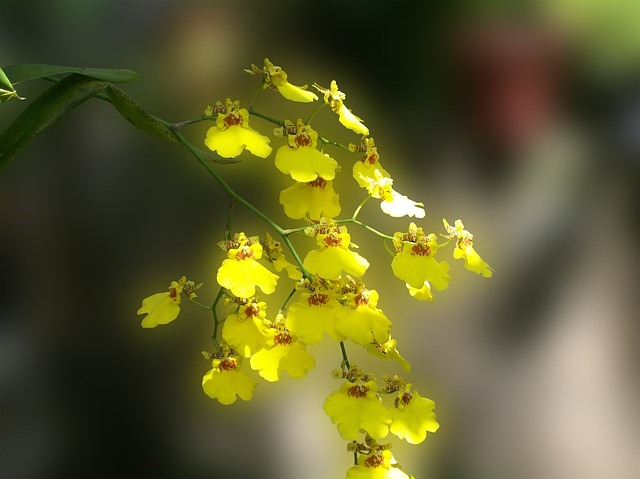 Oncidium varicosum is a popular species, producing a shower of bright, sunny blooms. Image by Carmem Cândido Rodrigues Carlotinha.
Oncidium varicosum is a popular species, producing a shower of bright, sunny blooms. Image by Carmem Cândido Rodrigues Carlotinha.Get to Know Oncidium Orchids
Oncidium orchid flowers vary greatly, but share one common feature: the large lower petal, called a lip, is always perpendicular to the side winged petals.
The distinctive shape of the blooms, carried on many-branched stems give Oncidium orchid its common name: Dancing Lady Orchid. In their natural habitats, Oncidiums flutter in the breeze, making them "dance."
In the wild, almost all Oncidium (pronounced on-sid-ee-um) orchids are epiphytes, growing on tree branches where they anchor themselves with their thick roots. They like free-flowing air as in their native habitats. Put them where they'll enjoy air circulation, away from heat or AC vents.
How tall do they get? Oncidium species vary widely, but many range from 12-30 in (30-75 cm) tall.
Several hundred species exist, native to tropical and subtropical habitats, including the high Andes mountains, the humid forests of Jamaica, and the tropical river valleys of Brazil, Ecuador and Peru.
What these dancing sprays of flowers have in common is a love of humidity. If the relative humidity drops below 50%, use a pebble tray or room humidifier to increase the moisture in the air. Grouping plants also helps to maintain the humidity around them. You can mist the foliage every day -- they won't mind.
Oncidium Varieties
Most oncidiums you'll find are hybrids, involving several species. These complex hybrids produce more flowers, bloom more often, and grow faster than the species. Oncidium hybrids offer some gorgeous varieties.
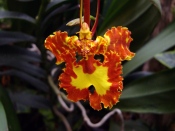 O. papilio "Butterfly Orchid"
O. papilio "Butterfly Orchid"O. varicosum, shown above, is a popular species, producing a shower of bright, sunny blooms.
Oncidium papilio, shown here, is called the Butterfly Orchid. This is one of the few orchids that bloom in succession, a flower at a time, from spring through autumn. Spectacular colors and easy to grow -- what's not to love?
'Sharry Baby' shown below, is an easy orchid for beginners, offering a profusion of red and white, sweetly scented flowers. It's easy to see why this is one of the most popular Oncidiums.
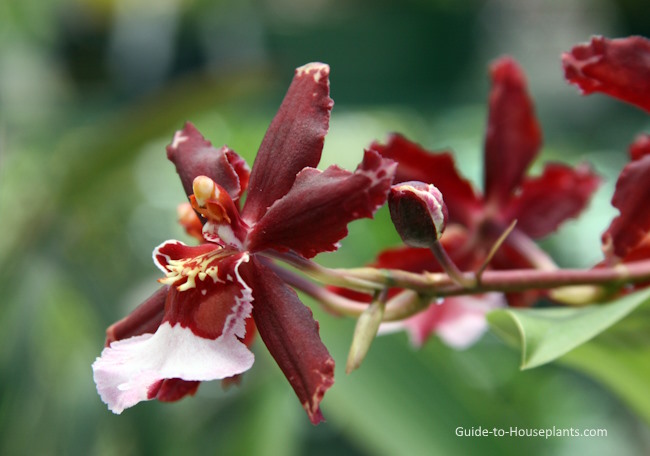 'Sharry Baby' is a gorgeous Oncidium cultivar that is deliciously scented like chocolate.
'Sharry Baby' is a gorgeous Oncidium cultivar that is deliciously scented like chocolate.Growing Oncidiums Year-Round
Shed some light. Oncidium orchid plants need plenty of light all year, but not direct sun. If you don't have a spot near a window, artificial lighting works beautifully. Fluorescent bulbs are efficient. Use 1 warm white tube and 1 cool white tube under a reflector. Place orchids about 6 inches (20 cm) beneath the light for 14-16 hours a day. It's also important to give them darkness at night. Plants need a rest, too.
To repot...or not. Fir bark medium breaks down after a couple years and needs replaced. The best time to repot your orchid is when new growth begins, shortly after blooming is over.
Got a reluctant bloomer? Give your orchid slightly cooler nighttime temperatures to spark blooming. A 15° difference will do. Oncidiums will tolerate varying temperatures from 55° nights up to 75° days. Blooming time varies by species and some give more than 1 show of blooms throughout the year. With good Oncidium orchid care, you can expect blooms year after year.
Something bugging your orchid plant? Mealybugs are the most destructive pest for orchids. They are tiny, white and fuzzy, and tend to cluster along the flower stems and the base of the leaves. You can help to prevent them by gently wiping the leaves with a damp cloth. Isolate an infested houseplant to prevent pests from moving on to your other indoor plants, then treat it right away.
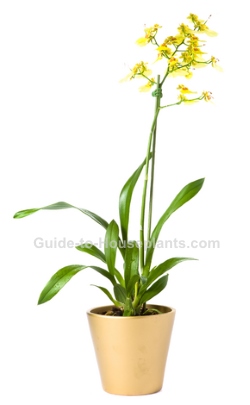
Oncidium Orchid Care Tips
Light: Good orchid care also includes bright, indirect sunlight. Don't have space near a bright window? Fluorescent lights work well, too.
Water: Keep the medium lightly moist during the growing season. Be careful not to overwater. Oncidiums store water in their pseudobulbs, making them more tolerant of dry soil than wet. Water less during other times of the year, allowing soil to become almost completely dry between thorough waterings.
Humidity: Moderate, preferably 50-60% relative humidity. Use a humidity tray or room humidifier, if needed.
Temperature: 55-60°F/13-16°C nights and 65-75°F/18-24°C days; slightly cooler nights will help these beauties bloom.
Soil: Orchid potting mix
Fertilizer: Feed during active growth every third time you water, mixing organic orchid fertilizer to one-half the recommended amount on the label. Take care not to over feed your Oncidiums because they are sensitive to fertilizer burn. Brown leaf tips are a sign you've over done it.
Propagation: Division. Divide into clumps of at least 4 pseudobulbs each.
